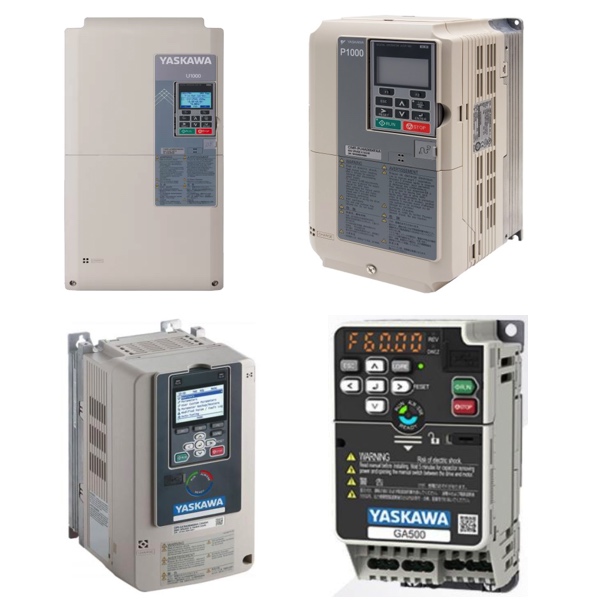Yaskawa VFDs

Yaskawa Variable Frequency Drives (VFDs)
Yaskawa Variable Frequency Drives (VFDs) are trusted for their performance, advanced motor control, and long-term reliability. These drives give you precise control over motor speed and torque, improving energy efficiency, process accuracy, and overall equipment life. That’s why they’re used in demanding applications like HVAC systems, pumps, conveyors, cranes, and machine tools.
Yaskawa VFDs are built to handle a wide range of motor types and system requirements. They can be easily programmed to fit almost any application — from light-duty equipment to complex industrial automation.
Modern Yaskawa drives, including the GA800, GA500, and FP605, use advanced control technologies such as vector control and flux vector control to deliver smooth, consistent motor operation under any condition. Whether you need precision torque management, regenerative efficiency, or network connectivity, there’s a Yaskawa drive designed to fit your needs.
To get the most from your setup, pair your drive with VFD accessories such as filters, reactors, keypads, and enclosures — with most products available from RSP Supply for same-day shipping and expert support.
More About Yaskawa VFDs
Yaskawa drives have a great reputation for being reliable, efficient, and easy to work with. At RSP Supply, we keep a wide selection in stock — including the GA800, GA500, FP605, and IQPump1000. These are Yaskawa’s latest models and replace older versions like the A1000, P1000, and V1000.
Yaskawa GA800
The GA800 is one of Yaskawa’s most flexible and capable drives. It can run just about any motor type, induction, permanent magnet, or synchronous reluctance, and it does so smoothly and efficiently. It’s easy to set up, has built-in networking options, and is made to last for years with very little upkeep.
Yaskawa GA500
The GA500 may be small, but it packs a lot of power. It’s a great choice for OEMs and panel builders who need a compact, reliable drive. It’s simple to program using a USB connection or Bluetooth, no external power needed, and is built to handle up to ten years of continuous use.
Yaskawa FP605
The FP605 is designed for HVAC, fan, and pump applications. It’s the updated version of the old P1000 and offers better efficiency, quieter operation, and a smaller footprint. It helps cut energy costs and makes installation faster and easier.
Yaskawa IQPump1000 Drive
The IQPump1000 Drive takes things a step further. It converts input AC power directly to output AC power, which means fewer components, cleaner power, and built-in regenerative capability. It’s a great option when you want maximum efficiency and minimal harmonics.
Common Questions
Q: Which drives replace the A1000 and P1000?
The GA800 replaces the A1000, and the FP605 replaces the P1000. Both offer improved efficiency, easier setup, and more advanced control.
Q: Do you stock these drives for same-day shipping?
Yes! We keep the a wide variety of GA800, GA500, and FP605 models in stock and ready to ship the same day you order.
Motor Starters, Soft Starters & VFDs
In industrial motor control, how a motor starts and stops can make all the difference in performance, safety, and equipment life. The three main control methods; motor starters, soft starters, and variable frequency drives (VFDs) each serve a specific purpose.
Motor Starters
A motor starter is the simplest way to start and stop a motor safely. It includes a contactor, overload, and circuit protection to handle basic on/off control. Starters are reliable, affordable, and work well when torque and speed aren’t critical. However, because they deliver full voltage instantly, they can create a large inrush current and mechanical stress on the motor.
Soft Starters
A soft starter ramps voltage up slowly to protect motors from high inrush current and torque shock. They’re a good middle ground between basic starters and VFDs; ideal for pumps, conveyors, and fans. Soft starters reduce wear, extend motor life, and save space compared to a VFD, but they don’t allow full-speed control.
Variable Frequency Drives (VFDs)
A VFD gives you full speed and torque control by varying the frequency and voltage supplied to the motor. They provide smooth startup, efficient operation, and energy savings, making them a favorite in modern automation systems. VFDs cost more than other options but offer unmatched flexibility, monitoring, and long-term savings.
Choosing the Right Option
Each method has its place:
- Motor starters for simple, low-cost control.
- Soft starters for gentle starting and longer motor life.
- VFDs for full control, energy savings, and efficiency.
Need help deciding which is best for your application? Contact RSP Supply — our team can guide you to the right solution.

